Assignment:
Fundamentals of Physics,
1. In a double-slit arrangement the slits are separated by a distance equal to 110 times the wavelength of the light passing through the slits.
(a) What is the angular separation between the central maximum and an adjacent maximum?
(b) What is the distance between these maxima on a screen 52.4 cm from the slits?
2. A double-slit arrangement produces interference fringes that have an angular separation of 3.32 x 10-3 rad for light with a wavelength of λ = 418 nm. For what wavelength would the angular separation be 9.93% greater?
3. Monochromatic light of wavelength 555 nm illuminates two parallel narrow slits 6.07 μm apart. Calculate the angular deviation of the third-order (for m = 3) bright fringe? Units
4. We wish to coat flat glass (n = 1.50) with a transparent material (n = 1.27) so that reflection of light at wavelength 689 nm is eliminated by interference. What minimum thickness can the coating have to do this? (in nm)
5. A 660-nm-thick soap film (n = 1.43) in air is illuminated with white light in a direction perpendicular to the film. For how many different wavelengths in the 300 to 700 nm range is there
a. (a) fully constructive interference (__units)
b. (b) Fully destructive interference in the reflected light? (__units)
6. The rhinestones in costume jewelry are glass with index of refraction 1.50. To make them more reflective, they are often coated with a layer of silicon monoxide of index of refraction 2.00. What is the minimum coating thickness needed to ensure that light of wavelength 471 nm and of perpendicular incidence will be reflected from the two surfaces of the coating with fully constructive interference? ____nm
7. Monochromatic light of wavelength 577 nm is incident on a narrow slit. On a screen 1.51 m away, the distance between the second diffraction minimum and the central maximum is 1.73 cm.
a. (a) Calculate the angle of diffraction θ of the second minimum. (____units)
b. (b) Find the width of the slit in nanometers.(____units)
8. Light of wavelength 547 nm is incident on a narrow slit. The angle between the first diffraction minimum on one side of the central maximum and the first minimum on the other side is 1.34°. What is the width of the slit? (____units)
9. (a) How far from grains of red sand must you be to position yourself just at the limit of resolving the grains if your pupil diameter is 1.7 mm, the grains are spherical with radius 54 μm, and the light from the grains has wavelength 660 nm? ( _____units) (b) If the grains were blue and the light from them had wavelength 430 nm, would the answer to (a) be larger (show 1) or smaller (show 0)?
10. The radar system of a navy cruiser transmits at a wavelength of 1.5 cm, from a circular antenna with a diameter of 1.9 m. At a range of 8.3 km, what is the smallest distance in meters that two speedboats can be from each other and still be resolved as two separate objects by the radar system? (_____units)
11. A diffraction grating 23.3 mm wide has 8210 rulings. Light of wavelength 700 nm is incident perpendicularly on the grating. What are the (a) largest, (b) second largest, and (c) third largest values of θ at which maxima appear on a distant viewing screen?
a. _____degrees
b. _____degrees
c. _____degrees
12. A grating has 420 lines/mm. How many orders of the visible wavelength 524 nm can it produce in addition to the m = 0 order? (_____units)
13. The mean lifetime of certain subatomic particles is measured to be 1.7511 μs when they are stationary. However, the mean lifetime of fast-moving particles of the same kind observed in a burst of cosmic rays is measured to be 18.596 μs. What is the speed parameter β of these cosmic-ray particles relative to Earth? (_____units)
14. You wish to make a round trip from Earth in a spaceship, traveling at constant speed in a straight line for exactly 3 months (as you measure the time interval) and then returning at the same constant speed. You wish further, on your return, to find Earth as it will be exactly 1000 years in the future.
a. (a) To eight significant figures, at what speed parameter must you travel? (____units)
b. (b) Does it matter whether you travel in a straight line on your journey? (Yes/ No)
15. An unstable high-energy particle enters a detector and leaves a track 1.37 mm long before it decays. Its speed relative to the detector was 0.931c. What is its proper lifetime in seconds? That is, how long would the particle have lasted before decay had it been at rest with respect to the detector? (____units)
16. An electron of β = 0.999 995 moves along the axis of an evacuated tube that has a length of 2.32 m as measured by a laboratory observer S at rest relative to the tube. An observer S' at rest relative to the electron, however, would see this tube moving with speed v (=βc). What length would observer S' measure for the tube? (____units)
17. A meter stick in frame S' makes an angle of 42° with the x' axis. If that frame moves parallel to the x axis of frame S with speed 0.97c relative to frame S, what is the length of the stick as measured from S? (____units)
18. Observer S reports that an event occurred on the x axis of his reference frame at x = 2.51 x 108 m at time t = 1.89 s. Observer S' and her frame are moving in the positive direction of the x axis at a speed of 0.475c. Further, x = x' = 0 at t = t' = 0. What are the (a) spatial and (b) temporal coordinate of the event according to S'? If S' were, instead, moving in the negative direction of the x axis, what would be the (c) spatial and (d) temporal coordinate of the event according to S'?
a. _____units
b. _____units
c. _____units
d. _____units
19. The origins of two frames coincide at t = t' = 0 and the relative speed is 0.998c. Two micrometeorites collide at coordinates x = 114 km and t = 282 μs according to an observer in frame S. What are the (a) spatial and (b) temporal coordinate of the collision according to an observer in frame S'?
a. _____units
b. _____mus
20. An experimenter arranges to trigger two flashbulbs simultaneously, producing a big flash located at the origin of his reference frame and a small flash at x = 32.8 km. An observer, moving at a speed of 0.372c in the positive direction of x, also views the flashes. What is the time interval in seconds between them according to her? (____units)
21. A particle moves along the x' axis of frame S' with velocity 0.21c. Frame S' moves with velocity 0.68c with respect to frame S. What is the speed of the particle with respect to frame S? (____units)
22. Galaxy A is reported to be receding from us with a speed of 0.51c. Galaxy B, located in precisely the opposite direction, is also found to be receding from us at this same speed. What multiple of c gives the recessional speed an observer on Galaxy A would find for (a) our galaxy and (b) Galaxy B?
a. ______
b. ______
23. A spaceship, moving away from Earth at a speed of 0.974c, reports back by transmitting at a frequency (measured in the spaceship frame) of 81.3 MHz. To what frequency must Earth receivers be tuned to receive the report? (_____MHz)
24. How fast would you have to be moving for the 659 nm wavelength of a light source to appear as 588 nm to you, assuming that a relativistic calculation is not needed? (_____units)
25. How much work (in terms of MeV) must be done to increase the speed of an electron from rest to (a) 0.462c, (b) 0.981c, and (c) 0.9959c?
a. ______MeV
b. ______MeV
c. ______MeV
26. The mass of an electron is 9.109 381 88 x 10-31kg. Find (a) γ and (b) β for an electron with kinetic energy 23.5659 MeV.
a. ______units
b. ______units
27. How much work (in terms of keV) must be done to increase the speed of an electron from (a) 0.26c to 0.28c and (b) from 0.92c to 0.94c? Note that the speed increase is 0.02c in both cases.
a. _____keV
b. _____keV
28. What is the nuclear mass density <ρm of (a) the fairly low-mass nuclide 56Fe and (b) the fairly high-mass nuclide 210At? Compare the two answers, with an explanation.What is the nuclear charge density ρq of (c)56Fe and (d)210At? Compare the two answers, with an m explanation.
a. ______units
b. ______units
c. _____units
d. _____units
29. What is the mass excess Δ1 of 1H (whose actual mass is 1.007825 u) in (a) atomic mass units and (b) MeV/c2?
What is the mass excess Δn of a neutron (actual mass is 1.008665 u) in (c) atomic mass units and (d) MeV/c2?
What is the mass excess Δ120 of 120Sn (actual mass is 119.902197 u) in (e) atomic mass units and (f) MeV/c2?
a. _______units
b. _______MeV/c2
c. _______units
d. _______MeV/c2
e. _______units
f. _______MeV/c2
30. What is the binding energy per nucleon of the americium isotope
31. Cancer cells are more vulnerable to x and gamma radiation than are healthy cells. In the past, the standard source for radiation therapy was radioactive 60Co, which decays, with a half-life of 5.27 y, into an excited nuclear state of 60Ni. That nickel isotope then immediately emits two gamma-ray photons, each with an approximate energy of 1.2 MeV. How many radioactive 60Co nuclei are present in a 7000 Ci source of the type used in hospitals? (Energetic particles from linear accelerators are now used in radiation therapy.) ______units
32. The half-life of a radioactive isotope is 120 d. How many days would it take for the decay rate of a sample of this isotope to fall to 0.58 of its initial rate? (______units)
33. A radioactive nuclide has a half-life of 24.1 y. What fraction of an initially pure sample of this nuclide will remain undecayed at the end of 78.8 y? _____
34. A certain radioactive nuclide decays with a disintegration constant of 0.0143 h-1. (a) Calculate the half-life (in terms of hours) of this nuclide. What fraction of a sample will remain at the end of (b) 4.64 half-lives and (c) 7.69 days?
a. ______units
b. ______
c. ______
35. Plutonium isotope 239Pu decays by alpha decay with a half-life of 24100 y. How many milligrams of helium are produced by an initially pure 13.5 g sample of 239Pu at the end of 19610 y? (Consider only the helium produced directly by the plutonium and not by any by-products of the decay process.) _____units
36. The cesium isotope 137Cs is present in the fallout from aboveground detonations of nuclear bombs. Because it decays with a slow (30.2 y) half-life into 137Ba, releasing considerable energy in the process, it is of environmental concern. The atomic masses of the Cs and Ba are 136.9071 and 136.9058 u, respectively; calculate the total energy released in such a decay. (_____MeV)
37. The isotope 238U decays to 206Pb with a half-life of 4.47 x 109 y. Although the decay occurs in many individual steps, the first step has by far the longest half-life; therefore, one can often consider the decay to go directly to lead. That is,
238U → 206Pb + various decay products
A rock is found to contain 4.17 mg of 238U and 2.760 mg of 206Pb. Assume that the rock contained no lead at formation, so all the lead now present arose from the decay of uranium. How many atoms of (a) 238U and (b) 206Pb does the rock now contain? (c) How many atoms of 238U did the rock contain at formation? (d) What is the age of the rock?
a. _______
b. _______
c. _______
d. _______years
38. A radiation detector records 77 x 102 counts in 1.0 min. Assuming that the detector records all decays, what is the activity of the radiation source in (a)becquerels and (b)nanocuries?
a. _______units
b. _______units
39. A 83 kg person receives a whole-body radiation dose of 2.3 x 10-4 Gy, delivered by alpha particles for which the RBE factor is 12. Calculate (a) the absorbed energy (in terms of mJ) and (b) the dose equivalent.
a. _____MJ
b. _____units
40. During the Cold War, the Premier of the Soviet Union threatened the United States with 4.0 megaton 239Pu warheads. (Each would have yielded the equivalent of an explosion of 4.0 megatons of TNT, where 1 megaton of TNT releases 2.6 × 1028 MeV.) If the plutonium that actually fissioned had been 9.61% of the total mass of the plutonium in such a warhead, what was that total mass? (______kg)
41. An electron cannot decay into two neutrinos. Which of the following conservation laws would be violated if it did: (a) energy, (b) angular momentum, (c) charge, (d) lepton number, (e) linear momentum, (f) baryon number? (Several choices may be correct.)_____
42. A proton cannot decay into a neutron and a neutrino. Which of the following conservation laws would be violated if it did: (a) energy (assume the proton is stationary), (b) angular momentum, (c) charge, (d) lepton number, (e) linear momentum, (f) baryon number? (Several choices may be correct.) _______
43. Which conservation laws are violated in the proposed decay? Assume that the initial particle is stationary and the decay products have zero orbital angular momentum.
44. In the laboratory, one of the lines of sodium is emitted at a wavelength of 590.0 nm. In light from a particular galaxy, however, this line is seen at a wavelength of 614.3 nm. Calculate the distance (in ly) to the galaxy, assuming that Hubble's law holds and that the Doppler shift of Eq. 37-36 applies. (______units)
45. What is the observed wavelength of the 656.3 nm (first Balmer) line of hydrogen emitted by a galaxy at a distance of 1.94 x 108ly? Assume that the Doppler shift of Eq. 37-36 and Hubble's law apply. (______nm)
46. If Hubble's law can be extrapolated to very large distances, at what distance would the apparent recessional speed become equal to the speed of light? (_____ly)
47. At what rate does a star emit photons? For simplicity, assume that the star's entire emission at the rate of 4.9 x 1026 W is at the single wavelength of 550 nm. (______nm)
48. The meter was once defined as 1 650 763.73 wavelengths of the orange light emitted by a source containing krypton-86 atoms. What is the photon energy of that light? (______eV)
49. Light from a certain lamp is brightest at a wavelength of 603 nm. What is the photon energy (in eV) for light at that wavelength? (______units)
50. Light strikes a metal surface, causing photoelectric emission. The stopping potential for the ejected electrons is 6.3 V, and the work function of the metal is 2.5 eV. What is the wavelength of the incident light (in terms of nm)? (_______nm)
51. The work function of tungsten is 4.50 eV. Calculate the speed of the fastest electrons ejected from a tungsten surface when light whose photon energy is 5.62 eV shines on the surface. (______Km/s)
52. The wavelength associated with the cutoff frequency for silver is 325 nm. Find the maximum kinetic energy of electrons ejected from a silver surface by ultraviolet light of wavelength 253 nm. (_______eV)
53. Light of wavelength 5.46 pm is directed onto a target containing free electrons. Find the wavelength of light scattered at 101° from the incident direction. The electron Compton wavelength is 2.43 x 10-12 m. (_______pm)
54. What (a) frequency, (b) photon energy, and (c) photon momentum magnitude are associated with x rays having wavelength 34.5 pm?
a. _______Hz
b. _______units
c. _______units
55. In an old-fashioned television set, electrons are accelerated through a potential difference of 24.1 kV. What is the de Broglie wavelength of such electrons? (Relativity is not needed.) (_______pm)
56. Singly charged sodium atoms are accelerated through a potential difference of 238 V. (a)What is the momentum acquired by such an ion? (b) What is its de Broglie wavelength (in pm)? The mass of a sodium ion is 3.819 x 10-26 kg.
a. _______units
b. _______pm
57. The wavelength of the yellow spectral emission line of sodium is 590 nm. At what kinetic energy would an electron have that wavelength as its de Broglie wavelength? _______microeV
58. What is the wavelength of (a) a photon with energy 9.0 eV (in nm), (b) an electron with energy 9.0 eV (in nm), (c) a photon of energy 9.0 GeV (in fm), and (d) an electron with energy 9.0 GeV (in fm)?
a. ______nm
b. _______nm
c. _______units
d. _______units
59. A particle of mass 3.1 x 10-27 kg has a potential energy of 7.5 x 10-15 J, independently of its position. If its energy is 12 x 10-15 J, what is its angular wave number? (_____units)
60. An electron in a one-dimensional infinite potential well of length L has ground-state energy E1. The length is changed to L' so that the new ground-state energy is E1' = 0.660E1. What is the ratio L'/L? ______
61. The ground-state energy of an electron trapped in a one-dimensional infinite potential well is 3.0 eV. What will this quantity be if the width of the potential well is multiplied by 7? _______eV
62. What must be the width (in nm) of a one-dimensional infinite potential well if an electron trapped in it in the n = 1 state is to have an energy of 6.1 eV? _______nm
63. An electron is trapped in a one-dimensional infinite potential well. For what (a) higher quantum number and (b) lower quantum number is the corresponding energy difference equal to the energy difference 7E43 between the levels n4 and n3? (c) Can a pair of adjacent levels have an energy difference equal to 2E43? If no, then enter 0. If yes, then enter 1.
a. _______units
b. _______units
c. _______units
64. An electron is trapped in a one-dimensional infinite potential well that is 330 pm wide; the electron is in its ground state. What is the probability that you can detect the electron in an interval of width δx = 5.0 pm centered at x = 310 pm? (Hint: The interval δx is so narrow that you can take the probability density to be constant within it.) (_____units)
65. What is the ratio of wavelength #4 of the Balmer series to wavelength #4 of the Lyman series? (______units)
66. An atom (not a hydrogen atom) absorbs a photon whose associated wavelength is 235 nm and immediately emits a photon whose associated wavelength is 590 nm. How much net energy (in terms of eV) is absorbed by the atom in this process? (______eV)
67. What are the (a) energy (in eV), (b) magnitude of the momentum, and (c) wavelength (in nm) of the photon emitted when a hydrogen atom undergoes a transition from a state with n = 5 to a state with n = 3?
a. _______nm
b. _______units
c. ______nm
68. An atom (not a hydrogen atom) absorbs a photon whose associated frequency is 6.9 x 1014 Hz. By what amount does the energy (in terms of eV) of the atom increase? (_____eV)
69. What is the intensity of a traveling plane electromagnetic wave if Bm is 1.1 x 10-5 T?_____W/m^2
70. Assume (unrealistically) that a TV station acts as a point source broadcasting isotropically at 1.2 MW. What is the intensity of the transmitted signal reaching a nearby star that is 18 lyaway. (An alien civilization at that distance might be able to watch X Files.) A light-year (ly) is the distance light travels in one year. _______W/m^2
71. A plane electromagnetic wave has a maximum electric field of magnitude 2.98 x 10-6 V/m. Find the maximum magnetic field amplitude. ______T
72. In a plane radio wave the maximum value of the electric field component is 6.83 V/m. Calculate (a) the maximum value of the magnetic field component and (b) the wave intensity.
a. ______T
b. ______ W/m^2
73. The maximum electric field 10 m from a point light source is 1.6 V/m. What are (a) the maximum value of the magnetic field and (b) the average intensity of the light there? (c) What is the power of the source?
a. ______T
b. ______W/m^2
c. ______units
74. High-power lasers are used to compress a plasma (a gas of charged particles) by radiation pressure. A laser generating radiation pulses with peak power 2200 MW is focused onto 0.99 mm2 of high-electron-density plasma. Find the pressure exerted on the plasma if the plasma reflects all the light beams directly back along their paths. _______units
75. It has been proposed that a spaceship might be propelled in the solar system by radiation pressure, using a large sail made of foil. How large must the surface area (in m2) of the sail be if the radiation force is to be equal in magnitude to the Sun's gravitational attraction? Assume that the mass of the ship + sail is 1400 kg, that the sail is perfectly reflecting, and that the sail is oriented perpendicular to the Sun's rays. (With a larger sail, the ship is continuously driven away from the Sun.) The rate at which the Sun emits energy is 3.90 × 1026 W. The Sun's mass is 1.99 × 1030 kg. Gravitational constant is 6.67 × 10-11 N•m2/kg2. _______units
76. When the rectangular metal tank in the figure is filled to the top with an unknown liquid, observer O, with eyes level with the top of the tank, can just see corner E. A ray that refracts toward O at the top surface of the liquid is shown. If D = 93.4 cm and L = 2.30 m, what is the index of refraction of the liquid? ______units
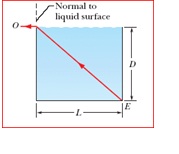
77. Light in vacuum is incident on the surface of a slab of transparent material. In the vacuum the beam makes an angle of 37.8° with the normal to the surface, while in the slab it makes an angle of 22.7° with the normal. What is the index of refraction of the transparent material? _______units
78. The figure shows light reflecting from two perpendicular reflecting surfaces A and B. Find the angle (in o) between the incoming ray i and the outgoing ray r'. ______units
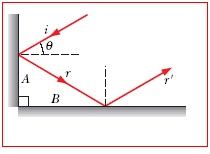
79. In the figure, light is incident at angle θ1 = 42.0° on a boundary between two transparent materials. Some of the light travels down through the next three layers of transparent materials, while some of it reflects upward and then escapes into the air. If n1 = 1.28, n2 = 1.42, n3 = 1.30 and n4 = 1.43, what is the value of (a)θ4 and (b)θ5?
a. _______units
b. _______units
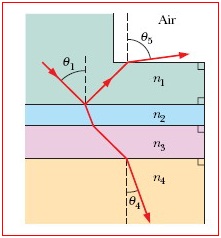
80. A point source of light is 65.3 cm below the surface of a body of water. Find the diameter of the circle at the surface through which light emerges from the water. Water has an index of refraction of 1.33.______cm
81. In the figure, a ray of light is perpendicular to the face ab of a prism (n = 1.41). Find the largest value for the angle so that the ray is totally reflected at face ac if the prism is immersed (a) in air and (b) in water (n=1.33).
a. _______units
b. _______units
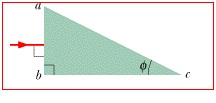
82. A lens is made of a transparent material having an index of refraction of 1.5. One side of the lens is flat, and the other convex with a radius of curvature of 25 cm. (a)Find the focal length of the lens. (b) If an object is placed 110 cm in front of the lens, where will the image be located?
a. _______cm
b. _______cm
83. A movie camera with a (single) lens of focal length 70 mm takes a picture of a person standing 35 m away. If the person is 160 cm tall, what is the height of the image in millimeters on the film? _______mm
84. You produce an image of the Sun on a screen using a thin lens whose focal length is 17.3 cm. What is the diameter of the image in millimeters? (Take the radius of the Sun to be 6.96 x 108 m and its distance to Earth to be 1.5 x 1011 m.) ________mm
85. An illuminated slide is held 75 cm from a screen. How far from the slide (between the slide and the screen) must a lens of focal length 6.7 cm be placed to form an image of the slide's picture on the screen? (Give the smaller of the two possible answers.) _______cm
86. In the figure, a real inverted image I of an object O is formed by a certain lens (not shown); the object-image separation is d = 31.4 cm, measured along the central axis of the lens. The image is just 1/2 the size of the object. (a) How far from the object must the lens be placed? (b) What is the focal length of the lens?
a. _______cm
b. _______cm
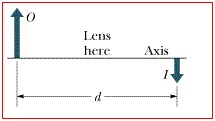
87. In a microscope of the type shown in the figure, the focal length of the objective is 5.89 cm, and that of the eyepiece is 9.98 cm. The distance between the lenses is 25.1 cm. (a)What is the tube length s? (b) If image I in the figure is to be just inside focal point F'1, how far from the objective should the object be? What then are (c) the lateral magnification m of the objective, (d) the angular magnification mθ of the eyepiece, and (e) the overall magnification M of the microscope?
a. ________units
b. ________units
c. ________units
d. ________units
e. ________units